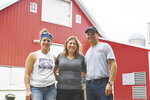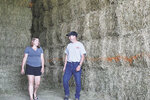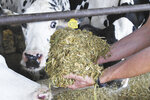


Describe your farm and facilities. We milk in a double-6 herringbone parlor. Our cows are housed in a freestall barn and our fresh cows are on a bedded pack. Fresh cows are milked four times a day for the first three weeks. Our regular herd is milked twice a day. We raise all our own replacements. On the farm, our family is assisted by our herdsperson, Emily Ludewig, as well as three interns who do most of the milking. My brother and some neighbors help as needed on the farm.
What forages do you harvest? We do a lot of rye. We harvest that first in the spring. This year we harvested it in mid-May. We usually harvest alfalfa as 50% haylage and 50% dry hay. All of our corn goes into silage. This year we are trying sorghum after rye. Usually, we would put corn after rye, but this year we have enough corn silage.
How many acres of crops do you raise? We have 450 acres that are all farmed for feed for the cows.
Describe the rations for your livestock. Our milk cows receive 10 pounds of ground dry corn, 8 pounds of protein, 3 pounds of soybean meal, 5 pounds of dry hay, 20 pounds of haylage and 75 pounds of corn silage. Our dry cows receive 12 pounds of grass hay and 30 pounds of corn silage. Close-up dry cows also get 3 pounds of grain and 3 pounds of protein mix. Heifers 8-20 months of age get 40 pounds of oatlage or ryelage, 4 pounds of dry hay and 10-15 pounds of corn silage.
What quality and quantity do you harvest of each crop? This year’s rye crop was exceptional. We harvested about 600 tons off 80 acres. The protein was 17%, which was almost as good as our alfalfa. We harvested 35 acres of first crop alfalfa as haylage. We got about 110 feet of bag length on a 12-foot-diameter bag. We baled about 90 acres of dry hay and harvested just over five big square bales per acre. That was an exceptional yield for dry hay; the average is about four bales an acre. I don’t shoot for the highest quality possible. First crop seems to feed exceptionally well. If it’s over 140 relative feed value and doesn’t get rained on, I am happy. It seems like the first crop has better fiber and the cows really milk well on it. A 140 RFV first crop is as good as a 160 RVF second or third crop. Because of the rain, we cut about a week later than ideal on first crop dry hay. The RFV was 125-135, so not quite what I wanted.
Describe your harvesting techniques for alfalfa and corn silage. We use a self-propelled chopper. We cut and windrow it and then merge two windrows together. We cut on day one and then chop late on day two or wait a full day between. For dry hay, we put it in windrows, rake it on day three and try to bale it on day four. Regardless of moisture, I add a preservative, even if it is 15% or less moisture. It just seems like it is good insurance. For corn silage, we like to harvest it at 66%-67% moisture with a 3/4 inch cut length, process it and put it in bags. All our forage is in bags. I love them, I think you can’t get better feed. We’re at the point where we almost need a bigger bagger, but the feed is always fresh.
What techniques do you use to store, manage and feed your forages? We have a 12-foot bagger and a concrete pad for most of the bags. The bags that are not on the cement we usually put corn silage in instead of hay because they are easier to manage. We use them in the winter when it’s supposed to be frozen. We clean up the bag every other day. We cut off the plastic and keep it fresh that way. We use about 1.5 feet of haylage and 4-5 feet of corn silage per day. We use a total mixed ration mixer and use a nutritionist through Hubbard Feeds. We raise 100% our own feed except for some dry corn.
How do quality forages play in the production goals for your herd? My philosophy on forage quality is that the most important thing for getting milk out of cows is consistent, fresh feed delivered daily at the same time. I think that is more important than quality. Right now, our cows are averaging 85 pounds of milk per day and I’m happy with that. Once we get into the 90s, we see more mastitis flare-ups and other health issues. I’ll take less milk with healthier cows than more milk with more issues. We don’t push our cows as hard as we could, but I’m OK with where they’re at.
What are management or harvesting techniques you have changed that has made a notable difference in forage quality? The self-propelled forage harvester we bought two years ago. We are able to make things in a timely fashion, so on those days when it is drying really quickly, we can get ahead of it before it gets too dry. When you get better moisture, the feed sticks together better and isn’t as sortable.
Describe a challenge you overcame in reaching your forage quality goals. We do double cropping with the rye. We tried this about 20 years ago, but I wasn’t satisfied with the crop after the rye. Getting a good seedbed was a big issue. Now, we have been doing vertical tillage after the rye is harvested and roll it. It makes a much nicer seed bed and the crops do better afterwards.
Comments
No comments on this item Please log in to comment by clicking here